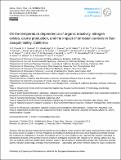| dc.contributor.author | Pusede, S. E. | |
| dc.contributor.author | Gentner, D. R. | |
| dc.contributor.author | Wooldridge, P. J. | |
| dc.contributor.author | Rollins, A. W. | |
| dc.contributor.author | Min, K.-E. | |
| dc.contributor.author | Russell, A. R. | |
| dc.contributor.author | Thomas, J. | |
| dc.contributor.author | Zhang, L. | |
| dc.contributor.author | Brune, W. H. | |
| dc.contributor.author | Henry, S. B. | |
| dc.contributor.author | DiGangi, J. P. | |
| dc.contributor.author | Keutsch, F. N. | |
| dc.contributor.author | Harrold, S. A. | |
| dc.contributor.author | Thornton, J. A. | |
| dc.contributor.author | Beaver, M. R. | |
| dc.contributor.author | St. Clair, J. M. | |
| dc.contributor.author | Wennberg, P. O. | |
| dc.contributor.author | Sanders, J. | |
| dc.contributor.author | Ren, X. | |
| dc.contributor.author | VandenBoer, T. C. | |
| dc.contributor.author | Markovic, M. Z. | |
| dc.contributor.author | Guha, A. | |
| dc.contributor.author | Weber, R. | |
| dc.contributor.author | Goldstein, A. H. | |
| dc.contributor.author | Cohen, R. C. | |
| dc.contributor.author | Browne, Eleanor C. | |
| dc.date.accessioned | 2014-06-16T19:31:53Z | |
| dc.date.available | 2014-06-16T19:31:53Z | |
| dc.date.issued | 2014-04 | |
| dc.date.submitted | 2014-01 | |
| dc.identifier.issn | 1680-7324 | |
| dc.identifier.issn | 1680-7316 | |
| dc.identifier.uri | http://hdl.handle.net/1721.1/88011 | |
| dc.description.abstract | The San Joaquin Valley (SJV) experiences some of the worst ozone air quality in the US, frequently exceeding the California 8 h standard of 70.4 ppb. To improve our understanding of trends in the number of ozone violations in the SJV, we analyze observed relationships between organic reactivity, nitrogen oxides (NO[subscript x]), and daily maximum temperature in the southern SJV using measurements made as part of California at the Nexus of Air Quality and Climate Change in 2010 (CalNex-SJV). We find the daytime speciated organic reactivity with respect to OH during CalNex-SJV has a temperature-independent portion with molecules typically associated with motor vehicles being the major component. At high temperatures, characteristic of days with high ozone, the largest portion of the total organic reactivity increases exponentially with temperature and is dominated by small, oxygenated organics and molecules that are unidentified. We use this simple temperature classification to consider changes in organic emissions over the last and next decade. With the CalNex-SJV observations as constraints, we examine the sensitivity of ozone production (PO[subscript 3]) to future NO[subscript x] and organic reactivity controls. We find that PO[subscript 3] is NO[subscript x]-limited at all temperatures on weekends and on weekdays when daily maximum temperatures are greater than 29 °C. As a consequence, NO[subscript x] reductions are the most effective control option for reducing the frequency of future ozone violations in the southern SJV. | en_US |
| dc.description.sponsorship | California Environmental Protection Agency. Air Resources Board (Contract CARB 08-316) | en_US |
| dc.description.sponsorship | United States. National Aeronautics and Space Administration (Grant NNX10AR36G) | en_US |
| dc.language.iso | en_US | |
| dc.publisher | Copernicus GmbH | en_US |
| dc.relation.isversionof | http://dx.doi.org/10.5194/acp-14-3373-2014 | en_US |
| dc.rights | Creative Commons Attribution | en_US |
| dc.rights.uri | http://creativecommons.org/licenses/by/3.0/ | en_US |
| dc.source | Copernicus Publications | en_US |
| dc.title | On the temperature dependence of organic reactivity, nitrogen oxides, ozone production, and the impact of emission controls in San Joaquin Valley, California | en_US |
| dc.type | Article | en_US |
| dc.identifier.citation | Pusede, S. E., D. R. Gentner, P. J. Wooldridge, E. C. Browne, A. W. Rollins, K.-E. Min, A. R. Russell, et al. “On the Temperature Dependence of Organic Reactivity, Nitrogen Oxides, Ozone Production, and the Impact of Emission Controls in San Joaquin Valley, California.” Atmospheric Chemistry and Physics 14, no. 7 (April 4, 2014): 3373–3395. | en_US |
| dc.contributor.department | Massachusetts Institute of Technology. Department of Civil and Environmental Engineering | en_US |
| dc.contributor.mitauthor | Browne, Eleanor C. | en_US |
| dc.relation.journal | Atmospheric Chemistry and Physics | en_US |
| dc.eprint.version | Final published version | en_US |
| dc.type.uri | http://purl.org/eprint/type/JournalArticle | en_US |
| eprint.status | http://purl.org/eprint/status/PeerReviewed | en_US |
| dspace.orderedauthors | Pusede, S. E.; Gentner, D. R.; Wooldridge, P. J.; Browne, E. C.; Rollins, A. W.; Min, K.-E.; Russell, A. R.; Thomas, J.; Zhang, L.; Brune, W. H.; Henry, S. B.; DiGangi, J. P.; Keutsch, F. N.; Harrold, S. A.; Thornton, J. A.; Beaver, M. R.; St. Clair, J. M.; Wennberg, P. O.; Sanders, J.; Ren, X.; VandenBoer, T. C.; Markovic, M. Z.; Guha, A.; Weber, R.; Goldstein, A. H.; Cohen, R. C. | en_US |
| mit.license | PUBLISHER_CC | en_US |
| mit.metadata.status | Complete | |
